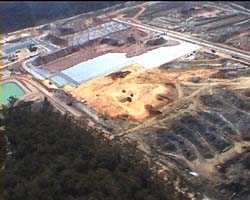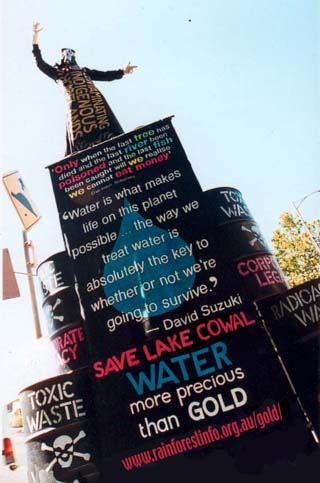THE
LAKE COWAL CAMPAIGN
Media
Releases
| Action Alert
| Campaign
Video
Photos
| Coalition
to Protect Lake Cowal
Barrick
Gold in the News |
Sacred
Fire
Donations | Convergence
Site| Commission
of Inquiry report
NEW **Letter to the Editor Action Kit **
GoldBusters | Cyanide |Eco-Gold!? | Rainforest Information Centre

THE
LAKE
Situated 47 kilometers north east of West Wyalong in central New South Wales (NSW), Lake Cowal is the state’s largest natural inland lake. It is part of the Wilbertroy-Cowal Wetlands within a large flood plain, the Jemalong Plain. Fed by its major tributary Bland Creek and by occasional floods from the Lachlan River, the lake is ephemeral but is substantially full for seven out of ten years. As floods recede Lake Cowal drains back into the Lachlan communicating with the Murray River.
Lake Cowal is included in the Australian Register of the National Estate and in its Directory of Important Wetlands. The National Trust of Australia (NSW) has listed Lake Cowal as a 'Landscape Conservation Area'. The Australian Heritage Commission has suggested the NSW government consider the Lake Cowal region for listing under the Ramsar Convention as a Wetland of International Importance.
Under the
Ramsar Convention on Wetlands contracting parties (of which Australia
is one) are obliged to promote conservation, repair and wise use of all
wetlands. Australia has already lost 89% of its wetlands over the last
century.
The New South Wales National Parks and Wildlife Services (NSW NPWS) states,
“Lake Cowal is listed on the National Estate because of the diversity
and number of species that inhabit the lake. For example, Lake Cowal has
at least three recorded accounts of more than 1% the Australian population
of some wader species. As such, Lake Cowal also meets the Ramsar Wetlands
of Importance listing criteria. The NPWS is of the opinion that Lake Cowal
provides significant wetland habitats and drought refuge both in area,
diversity of habitat types and duration of availability of resources.”






